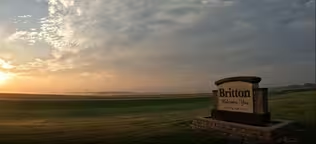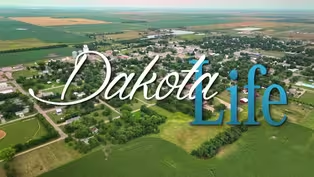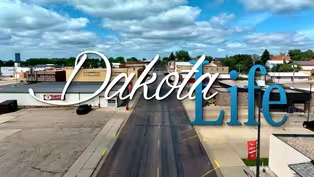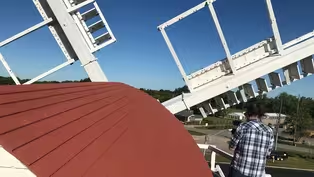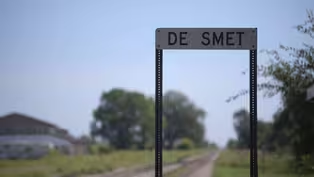Dakota Life
Greetings From Redfield
Season 24 Episode 9 | 28m 16sVideo has Closed Captions
Greetings From Redfield
Dakota Life tours the historic Carnegie library, visits some of the local entrepreneurs revitalizing downtown Redfield, meets a connoisseur of vintage seed bags, and takes you to a ranch outside of Redfield where the father and son duo train their horses for Hollywood.
Problems playing video? | Closed Captioning Feedback
Problems playing video? | Closed Captioning Feedback
Dakota Life is a local public television program presented by SDPB
Support Dakota Life with a gift to the Friends of Public Broadcasting
Dakota Life
Greetings From Redfield
Season 24 Episode 9 | 28m 16sVideo has Closed Captions
Dakota Life tours the historic Carnegie library, visits some of the local entrepreneurs revitalizing downtown Redfield, meets a connoisseur of vintage seed bags, and takes you to a ranch outside of Redfield where the father and son duo train their horses for Hollywood.
Problems playing video? | Closed Captioning Feedback
How to Watch Dakota Life
Dakota Life is available to stream on pbs.org and the free PBS App, available on iPhone, Apple TV, Android TV, Android smartphones, Amazon Fire TV, Amazon Fire Tablet, Roku, Samsung Smart TV, and Vizio.
Providing Support for PBS.org
Learn Moreabout PBS online sponsorshipMore from This Collection
Dakota Life stories from towns in northeast South Dakota
Video has Closed Captions
Visit Britton and learn about people who do good in this Marshall County town. (29m 45s)
Video has Closed Captions
Milbank is a vibrant community on the eastern edge of South Dakota’s glacial lakes (26m 58s)
Video has Closed Captions
Travel with us to Desmet, Arlington, Viborg, the Black Hills and Clear Lake. (28m 15s)
Providing Support for PBS.org
Learn Moreabout PBS online sponsorship(upbeat music) - [Announcer] This is a production of South Dakota Public Broadcasting.
- Redfield was born during an era known as the Great Dakota Boom.
The 1880 census counted the population in Spink County at 477.
A decade later, it was over 10,000.
During this time, railroads laid over 2,000 miles of track, and hundreds of towns were platted in Dakota territory and often by the railroads themselves.
Marvin Hewitt was general manager of the Chicago Northwestern Railway.
As the line expanded into the James River Valley, he toured the area on a buckboard, and it was him who chose the town sites of Watertown, Huron, and here in Redfield.
Briefly known as Stennett Junction, in 1881, Redfield was renamed after James Redfield, a Chicago and Northwestern auditor.
That year brought a tough winter for the families who were homesteading year round here in the Redfield area.
Legend has it that they were forced to grind wheat with hand-powered coffee mills.
When all but one broke, the eight families in town shared the last one, grinding wheat in shifts at any hour of the day.
The weather improved as did the flour milling technology.
It progressed rapidly, not only in Redfield but around the world.
You see, George Christian, the owner of a mill in Minneapolis and another one here in Redfield, helped pioneer the chilled iron roller process for milling wheat.
The substitution of rollers for the millstones made it possible to grind hard spring wheat into flour, and that opened possibilities for farmers all around Spink County and all around the Northwest.
As fields of red winter wheat took root on the prairie, Redfield grew, and people used their coffee mills for coffee.
Welcome to "Dakota Life," and greetings from Redfield.
(upbeat music) - [Announcer] This program was made possible with your support and with corporate support from Redfield Energy, producing 65 million gallons of ethanol each year from locally grown corn.
Proud supporters of South Dakota's ag industry and community, and by Agtegra Cooperative, an ag partner that shares the values of its members.
Strong, stable, dependable, and local.
- Long before Marvin Hewitt surveyed the James River Valley for the railroad, Native American tribes would gather near Redfield at a site known as Council Stone.
The Council Stone was a black egg-shaped rock surrounded by a circle of stones.
It was where Lakota and Dakota people met for their annual tribal councils and trade fairs.
Remnants of earth lodges near the site go back 1,000 years or more.
Lakota chief Drifting Goose and his band lived nearby on the James River island known as Armadale.
That has since been flooded.
Drifting Goose resisted encroachment by settlers for many years.
He refused to sign the Fort Laramie Treaty, and then in 1879, President Rutherford B. Hayes signed an executive order to establish the Drifting Goose Reservation, the only reservation ever granted to a specific person, but it was too late.
While his band was away, settlers occupied Armadale Island.
Drifting Goose and his people resettled at the Crow Creek Reservation, and then in 1880, Hayes revoked his own order.
Before the town of Redfield was officially incorporated, there was a six-year battle with Ashton over which community would be named the Spink County seat.
In the dispute election of 1883, Redfield citizens actually removed the voting records from a farmhouse at the old Ashton town site.
The territorial militia was sent in from Fargo to help keep the peace, but cooler heads prevailed by the time they arrived.
Another vote was held in 1886, and this time, Redfield won handily.
In 1908, three local farmers traveled to Grants Pass, Oregon.
When they came back, they had three pairs of ring-necked pheasants, so they released them near Hagman's Grove, just north of Redfield.
Well, the rest is history.
Area residents continued their efforts to establish a pheasant population, and then in 1911, the State Department of Game and Fish got involved, too.
They released 48 pairs of pheasants near Redfield, and by 1919, pheasants were well enough established that the state declared its inaugural pheasant season.
It was one day only, and it was only in Spink County.
Well, hunters have flocked to South Dakota ever since, and many recognize Redfield as the pheasant capital of the world.
Nowadays, fall and winter pheasant harvests usually run between one and two million birds.
What began at Hagman's Grove has developed into a cultural tradition, and it gets passed down through the generations.
Coming up, we're gonna tour the historic Carnegie Library.
We'll visit some of the creative entrepreneurs in downtown Redfield, and we'll meet a connoisseur of vintage seed bags.
But first, you've seen "Dances with Wolves," and if you look closely, you may be able to spot Redfield native Stan Schultz.
Stan and his son Nick have a passion for working with horses, a passion that has landed them roles on the big and small screen.
Their ranch near Redfield is where the father and son duo train their horses for Hollywood.
- [Greg] The name Stan Schultz may not light up the marque at your local movie theater, but chances are you've seen him on the big screen.
- Well, back in 1970, I joined the group of reenacters for a Fort Ransom cavalry.
Well, from that, the individuals that were responsible for bringing in extras for "Dances with Wolves" was familiar with our group and wanted to bring us in on that.
And so we had the military presence and equipment and protocol, and then doing the movie, it was just running through the numbers and doing what we do, and it was really quite successful for the movie industry to have reenacters that knew what to do when you give the direction to one individual, and then he shouts out the commands to the company.
- [Greg] And not too long after that, the movie business soon became a family affair.
- I was in the 4th grade when I got to go on my first movie.
It was "Crazy Horse," a TNT production.
It was pretty big deal.
I was pretty popular back at school.
The big actress on that one was Irene Bedard that was a voice of Pocahontas that just come out, the Disney voice of her.
And so I got an autographs for all the class and the teachers and everything, and so, yeah, it was pretty, pretty big deal for me at that time.
- [Greg] And after a few more appearances on the small and big screens, Stan was presented a chance to increase his footprint in Hollywood.
- In 2006, the British BBC came over to shoot "Custer's Last Stand," and they were needing horses for the actors for that particular film.
And the guy that was the coordinator for the project called me up, and it's a gentleman that I work with quite a bit, Jim Hatzell, out of Rapid City, and he asked if I would supply the horses for the actors.
So that went quite well.
(feed clatters in bucket) (soft dramatic music) - Come here, buddy.
- [Greg] And the work for Schultz Wrangling keeps evolving.
- [Nick] It turned into more of the horse work with the wrangling, bringing the horses in for the actors, and even in the last couple years, it's changed more into, in addition to what we're doing with the horses, the stunt work and character parts here and there that we get thrown into just 'cause we got the right look for something they're looking for.
So between all of it, it's we know in the business.
It's just we've gotten to do different things within the business.
It's been fun to see as well.
- [Greg] But some of the toughest parts is training the actors themselves.
- It's the one thing that we've had is real fortunate with all the different actors is that we usually build a pretty good rapport with them.
Part of their safety and health is in our hands, and so you gotta build that relationship with the actors and actresses and such.
And you got some that are just absolutely scared of horses, and you gotta try to get them over that fear.
- [Greg] The actors aren't the only ones need a little bit of training, too.
(Western music) - As training the horses, have to give 'em some scenarios that try to rattle 'em.
If they do rattle, we've had horses that perfect looking horse, great looking horse, and it's scared of everything, and until we get in there and start doing our action with them, we don't know what's gonna happen.
And then once we find out, then we can take 'em out onto the set.
- [Greg] And with the new family business starting to boom, that left the question whether the Schultz family would be leaving the family ranch outside of Redfield for the bright lights of Hollywood.
- We're a small town.
This is home for us.
We've got a lot of contacts all over the world, the people we've met, but it's just fun to be able to come back home after you go out and do these fun projects all over and still be a small town person.
(up-tempo upbeat music) - From horse pasture to what some people call pasture pool, for years, Redfield area golfers were playing a course that was one hole short.
Now they've got one spare.
Fisher Grove is located along the James River.
Lowland flooding on the river had reclaimed the 9th hole, so club members got together and raised money to add a new one.
It's called Perm's Point after a local baseball legend, Kirk Perman.
But for now, the river has surrendered its hold on the 9th hole, and that makes Fisher Grove a bit of an anomaly, a 10-hole golf course.
With the river's permission, Redfield area golfers are taking advantage of that extra hole while they can.
Other things have evolved here, too.
For 80 years, Redfield was the home of the South Dakota Developmental Center.
From a sometimes dark history of caring for people with intellectual disabilities, the center transformed, as did the care, with a greater focus on all people living meaningful lives together instead of one of segregation.
SDPB was part of a riveting documentary called "Leaving Redfield."
You could watch that through a link on our website at sdpb.org.
Small town ingenuity has taken another form in downtown Redfield.
Leo's Good Food is a former bank building that's been repurposed into a restaurant.
As a matter of fact, the salad bar is right over there in the old vault, and next door, a large retail space that stood empty for a while is now called Wild Roots.
It's home to many small businesses not large enough to have their own storefront.
- Our homemade caramel and cinnamon rolls are really popular.
That recipe is, I don't know where it came from, but it's been around for decades.
- [Larry] Not a lot has changed at Leo's Good Food.
Well, the location did once when the business moved across the street to a larger space.
- I was a sophomore in high school.
I can remember helping moving, pushing stuff over on a cart, and it was exciting starting new into a new place.
And everybody thinks it's interesting that there's a salad bar in the bank vault.
- [Larry] That's right, the salad bar in the bank vault.
Karen Gall's parents started the business in 1964.
Several years later, the move was made to a former bank building.
Karen and her brother are in charge now.
Karen returned from the food and service industry in Arizona.
- You go to the grocery store in Phoenix, you never see anybody you know, and then you come back to a small town, and every time you go in, you see somebody you know, which is really nice.
Miss that small town and knowing people and the community.
- [Larry] And Leo's has become not only a place for dining, including the homemade pies and desserts bake fresh daily, but it's also a gathering place in Redfield.
- People that play cards come in.
We have a card group that meets every Tuesday, a couple of different ones that meet once a month.
The president's room, a lot of people reserve that monthly.
It's fun to see people come back and visit Redfield that you haven't seen in a long time, and then we see people on a daily basis.
Every morning, the same guys come in at five in the morning, and if they're not here, we wonder what's wrong.
(laughs) - [Larry] Next door to Leo's, Jessica DeYoung created Wild Roots where a different menu of homemade is served.
- Right when you walk in, a flower shop, and people can even order or stop in and get anything, and then several different, like a seamstress that she makes all kinds of things, lots of different craft items and handmade items.
- [Larry] A hair stylist by trade, Jessica came to Redfield from Hill City once she married and settled in, well, for awhile.
- I just felt so content doing what I, so comfortable for so long, and I just thought, "There must be something more."
- [Larry] More turned out to be a large empty retail space downtown, a place for her creative retail ideas to take root.
- Build a salon, work in there, have the restaurant.
I didn't know I would run it, but, and then just offer.
I assumed there were people out there who had ideas who didn't want to just buy something or rent something or run something themselves, and I thought, "That would be a great opportunity to just invite people in."
- [Larry] One of those is Brenda Stover.
She's in charge of special education and other projects at the Redfield public schools.
- I have probably 30 staff underneath me, and I was making Christmas gifts for everybody.
Well, I just didn't stop, and I kept making all these Christmas trees, and Bonnie said, "Brenda, you have got to do something with these trees.
We don't have enough room in this house."
So then I went and got my hair done with Jess, and she said, "Well, get a table here.
You could sell 'em here."
- [Larry] And that was the start of Nana Bren's, one of many vendors that share the space at Wild Roots.
- I love wreaths and flowers and bows, sparkly things.
And then I started doing jewelry, so like these things, and they just pop in and out.
They're snaps, and I've got 'em everywhere.
I do my earrings, my necklace, my bracelets.
- [Larry] And the space has many more crafts and services like pain management, event rooms for parties, even tanning beds.
But what you don't see on the shelves are how everyone involved brings a special business skill to share and to help each other succeed.
They reimagine, repurpose, and grow from the roots.
It's a Redfield thing.
- [Brenda] This place is a really nice place to have for Redfield, and it just fell into place that I was able to join these ladies.
- Reusing and restoring buildings in Redfield includes the Rail Depot.
The Chicago Northwestern line from Huron reached Redfield in 1891.
In 1914, the railway built a new depot in the Gothic revival style, a unique design and rather unusual at the time for a small town depot.
You could ride a passenger train in and out of Redfield until 1961.
The freight service stopped some years later, and the depot was neglected for a while, but then in 2002, local funding was matched by a federal grant, and a restoration project began on the depot.
Today, it serves as a visitors center where people can learn about Redfield, see the model trains, engines, and artifacts from the railway's heyday.
The depot is just one of many standouts on a tour of Redfield architecture, which also includes the Carnegie Library, St. Bernard's Church, and Granite Hall.
The railroads were instrumental in bringing settlers to Dakota territory and exporting agricultural products that their labor and the land produced.
George Christian's new flour milling technology here in Redfield helped establish Dakota grown spring wheat as a staple.
Cyclone flour was one of the brands distributed from the Redfield mill.
A sack with a cyclone design hangs from the balcony in the Spink County Mercantile.
It's just one of the seed and grain bags that retired dentist and entrepreneur Clay Yeoman rescued.
His impressive collection marks an era when many small towns had their own local seed sellers, and there was a golden age of ag country seed bags.
(muffled chatter) - I gotta fly out Minneapolis on night.
- I'll come and appraise it for ya.
I'll condemn it, - No, no.
- and you can't sell it, - No, no.
- and you'll have to stay here.
- Then I just sell the land.
When I opened up the antique shop here, I think it was about 15 years ago I started buying bags.
I had a few before 'cause I had a little antique shop in Clark, too.
And I tried to find local ones, and I just liked the designs on 'em.
Some of 'em are funny.
Some of them are artistic, and I just liked the bags, and I started picking them up 'cause you could find 'em reasonably inexpensive in most places, though now they're getting a little pricier on some of 'em.
Over the years, I've collected enough to fill up the balcony here and have probably 20 or 30 more that I can't put on there 'cause I ran outta room.
I've got bags from Wentworth, Bristol, Bridgewater, Elk Point, Vermillion, Dell Rapids.
It almost seems like every little town had a seed company.
I'm guessing most of the ones I have are probably from 40s, 50s, and I'm guessing that's when they started having some of the fancier designs.
It was interesting in the Depression, some of the flour bags and different, they actually would do them in material, printed material, so people could make things out of 'em afterwards.
So they've always been somewhat useful, even not just as bags.
The flour sacks are more like dish towels, that type of material.
But people seem to hold onto 'em, a lot of 'em.
This is my favorite bag because I grew up in Dell Rapids, and I love that it has the Dells on it.
My friends and I would climb all over those in the summer.
And if my mother knew what we were doing all summer, we probably would've never allowed to go there, but just very happy memories of growing up.
They had to have a pretty good design team at the company that made the bags 'cause boy, there are so many different designs.
Some of 'em are similar.
Like I've got three different companies with three different pheasants on the bags.
Of course, the pheasants were a popular motif for South Dakota.
I've never sold any of the bags that I've put up, and people ask all the time.
Charlyn, my manager's probably tired of saying no.
- People always want to know if they can buy them.
I probably have said no two, 3,000 times in the last few months.
- I had one woman who came in maybe three or four years ago, and she saw one of the bags I had, and she was from Miller, and it was a Wilber's Seed Company, and that was her father, and she was trying to it a bag for each one of her kids.
- She got tears in her eyes, and she needed one more bag, and so Dr. Yeoman sold it to her.
And so we hunted and we hunted, and we found one for him, so we bought it and gave it to him.
Can't remember if it was Christmas or birthday, but we got it for him and gave it to him so he'd have it replaced.
- People know that I'm closing up here, so they've been coming in, and people have been asking about the bags for a long time, and now they coming in 'cause they're thinking I'm gonna sell the bags, which I probably am.
But a lot of 'em I'm surprised at how has been some, either they've worked for the company or they had family that owned some of the companies, and a lot of it is people who just collect things from their hometowns.
(gentle pleasant music) (muffled chatter) - Redfield wraps around highways 212 and 281, but it's not a straight shot through town.
You need to slow down and make a couple of turns.
It's the same for the Redfield City Park.
It winds around a bend on Turtle Creek.
That's a small tributary to the James River.
You can stroll to the ballparks, the playgrounds, or cross the pedestrian bridge.
Merle Legler Park, also known as Upper City Park, gives you a view from a street corner overlooking the larger park down below.
The stone benches and the lighthouse were built by the Civilian Conservation Corps, part of the New Deal program in the 1930s.
Dean Waddington of Redfield supervised that project.
The park is named after Merle Legler.
He owned a blacksmith shop in Redfield.
He wrote articles about town history and voluntarily maintained the park for many years.
One block east on 5th Avenue stands the Carnegie Library.
About 1/3 of the Carnegie Libraries built have been lost or repurposed, but not so in Redfield.
This one is the oldest one in continuous use as a library in the state of South Dakota.
- So we were founded in 1902, through a grant from Andrew Carnegie.
I believe it was $10,000, and we have been a library ever since 1902.
So that's 120 years.
1902, it was also the city offices.
They are now down the street, but it was the library and I believe the auditor was actually the first librarian.
- We're the only Carnegie Library, original Carnegie Library still using the building as Carnegie Library.
There's other Carnegie Libraries standing, but they're not used as a library anymore, so we're very proud of hat.
- So it's very small town.
I'm not from a small town, so it's a very small town library.
People come in and they know you.
You know them.
We actually don't have library cards here, physical library cards.
People come in and you just know their name or they just tell you their name.
We have a lot of children's programs.
Our story hour has been going on for at least since 1967 straight every year.
We don't actually know when it first started, but over 50 years we've had this story hour program going on, lots of people, lots of just small town life in a library.
- [Child] I want it to be colorful!
- Is that gonna be a colorful apple?
- Yeah.
- We deliver books to the nursing homes and assisted livings and that type of thing, and if someone was physically unable to come into the library, we made sure that they had access to what we had, and we would deliver it to them.
- [Sarah] We did have an addition in 2008, which doubled the size of the library.
So right now we're actually sitting in the space right between where the addition was created.
- [Dale] We thought that, yeah, the original part served its purpose well for (laughs) over 100 years, but we thought we needed, we're trying to not only expand technologically, but we're also trying to expand into more youth programs.
There's space.
The whole basement is there for, we could expand there for an adult when we're looking into expanding into more adult-oriented programs, book club type, book share type things, and we just thought we needed the space to do that.
- [Sarah] We're valued here.
It's an important landmark and building, and we wanna make sure that we keep that importance to the community.
(soft pleasant music) - [Dale] We can pass on the legacy to the next generations, and this town is used to having this place and this library and its services.
- [Sarah] The fact that we've had a library in Redfield for 120 years in the same building, it's crazy.
With everything modernizing to keep the historic aspect and actually keep the library going has been really special.
- From grinding flour in hand-powered coffee mills to survive the winter of 1881, Redfielders quickly moved on to harness innovative milling technology, and that opened export markets for locally grown amber waves of grain.
Redfield and Spink County grew rapidly with the Great Dakota Boom, but the boom had largely run its course by the time the drought struck in 1886.
Immigration into Spink County slowed, but the boom really never became a bust.
Credit some of that to forward thinking Redfield farmers who traveled to the West Coast and brought back a bird native to Asia.
Those birds have been feeding on Redfield-grown grains for over a century now.
They formed the center of a pheasant-rich oasis that's sought out each year by over a half million out of state hunters along with us residents.
You are historically correct to call Redfield the pheasant capital of the world.
And with creative entrepreneurs, expansive green space, and an outstanding architectural heritage, Redfield seems set to whether the next set of booms or busts.
If you're visiting, drop by for a sandwich at Leo's, get a style or pick up a craft in Wild Roots, and play nine holes or maybe 10.
Until then, you can revisit our stories about Redfield and all of our travels across the state at sdpb.org/dakotalife.
Thanks for coming along with us.
I'm Larry Rohrer.
For all of us at SDPB, thanks for watching.
(upbeat music)
Support for PBS provided by:
Dakota Life is a local public television program presented by SDPB
Support Dakota Life with a gift to the Friends of Public Broadcasting
